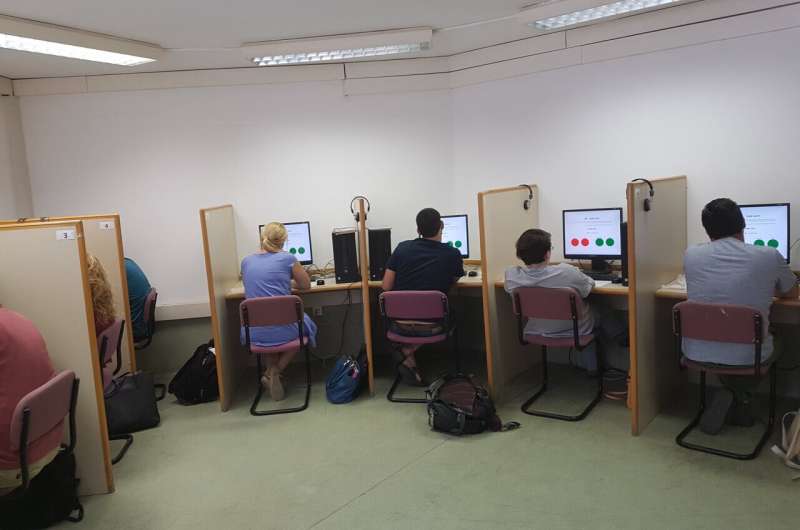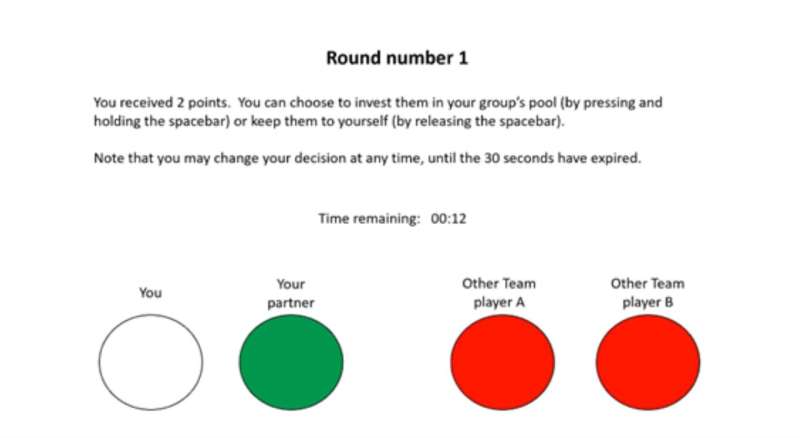April 8, 2024 feature
This article has been reviewed according to Science X's editorial process and policies. Editors have highlighted the following attributes while ensuring the content's credibility:
fact-checked
trusted source
proofread
Exploring how oxytocin interacts with testosterone while humans play a game modeling intergroup conflict

Over the past decades, numerous studies have investigated the neural and cognitive processes underpinning intergroup conflict, as this could help to explain what fuels belligerent behavior, political clashes, and wars. While these works gathered some interesting findings, much about these processes remains poorly understood.
Researchers at the Hebrew University of Jerusalem recently carried out a study specifically exploring how the hormones oxytocin and testosterone modulate people's behavior during an experimental game modeling intergroup conflict.
Their findings, published in Communications Psychology, suggest that oxytocin interacts with men's testosterone reactivity to modulate parochial altruism (i.e., behavior that benefits the group one belongs to, while negatively impacting competing groups).
"Individuals regularly carry out actions which are costly to themselves, but advance the interests of their own group, often even at the expense of rival groups," Salomon Israel, co-author of the paper, told Medical Xpress. "We see examples of such behavior all the time, including sports rivalries (playing injured), political partisanship (voting along party lines), and in extreme cases ethnic, religious, or national conflicts.
"Evolutionary theories, going back to Darwin, suggest that such acts of parochial altruism—the favoring of one's ingroup—emerged during human ancestry because they provided an advantage for group survival."
The researchers set out to study how individuals make decisions in a controlled laboratory setting modeling intergroup conflict, as this could shed light on the dynamics driving behaviors commonly observed outside laboratory settings.
Past social psychology research consistently found that people's social regard (i.e., their willingness to trust others, empathize with them and behave altruistically) is greatly influenced by their belonging to specific groups. Nonetheless, the biological underpinnings of these group-driven behaviors are yet to be clearly elucidated.
"We were inspired by previous research, which suggested independent roles of oxytocin and testosterone—hormones that are associated with intergroup relations and cooperationaggression—in shaping behavior during intergroup conflict," Boaz Cherki explained.
"Yet to our knowledge, how the two hormones interact, had yet to be tested. These hormones exert contrasting effects on various social behaviors, leading us to hypothesize that their combined influence might hold the key to understanding intergroup dynamics."
The primary objective of the recent work by Israel, Cherki and their collaborators was to better understand how the interaction between oxytocin and testosterone influences behavior in the context of intergroup conflict. While many past studies focusing on this topic only included male participants, the researchers decided to also include female participants, as this would allow them to discover any sex differences that may exist.
To model intergroup conflict in an experimental setting, the researchers used an adaptation of the game commonly referred to as "chicken." This game has often been portrayed in popular media, including in the movies "Rebel without a Cause," "Footloose" and "Grease," and is also used in political science to describe elements of conflict between nations, such as the nuclear brinkmanship of the Cuban Missile crisis.
"The classic version of the game of 'chicken' pits two drivers against each other on a collision course," Israel explained. "The first to swerve away is the 'chicken' and loses while the one who holds course is considered the winner. The games tension arises because both players have a strong incentive to avoid being labeled the chicken, but if neither swerves they face a catastrophic collision."
To carry out their experiments, Israel, Cherki and their colleagues used a laboratory-based adaptation of the chicken game, known as the "intergroup chicken game." This version of the game has the same underlying rules, but with players divided into groups that are pitted against each other.
"We combined this experimental decision-making game with two key biological methods," Israel explained. "First, we had participants provide saliva samples throughout the study so that we could assess changes in their testosterone levels throughout the experiment. Second, participants were randomly assigned to take nasal puffs containing 24 International Units of the hormone oxytocin or placebo, which allowed us to causally test the effect of nasally administered oxytocin on their behavior."
The researchers' experiment was double-blind and included a placebo condition. They recruited 204 participants and divided them into groups of eight or 12, each of which contained an equal number of males and females.
These groups of participants completed 30 rounds of the intergroup chicken game and at the beginning of each experimental session, participants were asked to self-administer either a placebo gas or oxytocin. Notably, neither the participants nor the experimenters were aware of what was being inhaled, which eliminated biases and prevented prior knowledge of what was administered during each trial from impacting the results.

"In this paradigm, participants are assigned to groups of two-player groups and play against a rival group," Cherki said. "At the beginning of each round, each player receives an endowment, and decides, independently, whether to keep the endowment or to invest it in the ingroup pool. If the number of investors in a group exceeds the number of investors in the rival group, its members receive a bonus; otherwise, no reward is given."
In the intergroup chicken game, investments made by players cannot be refunded and players who do not invest their endowment get to keep the money they received. This means that investing is only worthwhile if it will turn a tie into a group victory, as this would entail receiving a bonus that is higher than the money invested. In all other instances, however, players would gain more by keeping the endowment to themselves.
"Crucially, participants were afforded a signaling period preceding their final decision, allowing for strategic communication—a feature mirroring real-world scenarios where intentions are often conveyed through implicit cues," Cherki said.
"In each round, four circles that represented the players' intention signaling were shown on the participants computer screens (see example of screen layout below). When an ingroup member signaled 'invest,' their circle was colored in green, and when an outgroup member signaled 'invest,' their circle was colored in red."
In addition to recording the actions of players, the researchers collected samples of saliva from them both before and after the game, as these were later analyzed to record the reactivity of each individual to hormones at different points in time.
By analyzing the data they collected using regression-based statistical methods, Israel, Cherki and their colleagues then examined how the administration of intranasal oxytocin, testosterone reactivity, and sex of participants influenced intergroup behaviors during the game, particularly their likelihood to invest their endowments.
"Fundamentally, our study utilized a sophisticated mix of cutting-edge biological methods with behavioral experimentation, shedding light on the interplay of neurobiological factors in driving social behaviors during intergroup conflicts," Cherki said.
One of the most notable observations of this study was that the interaction between oxytocin and testosterone greatly influenced the behavior of male participants. Contrarily, the interplay between these two hormones did not appear to impact the behavior of female participants.
"We observed that under placebo conditions, elevations in testosterone levels corresponded to heightened aggression towards outgroups," Cherki said. "However, the administration of internasal oxytocin cancelled out this association, suggesting a regulatory role for oxytocin in moderating testosterone-induced aggression within intergroup dynamics."
Overall, the recent findings gathered by this team of researchers suggest that there could be notable sex differences in the dynamics underlying parochial altruism in intergroup conflict. In fact, they showed no substantial link between testosterone reactivity and outgroup aggression in females.
"This underscores the importance of considering sex-specific effects when examining the neurobiological underpinnings of social behavior," Cherki said. "Beyond these sex-specific insights, our findings reveal a novel pathway through which oxytocin and testosterone jointly influence human social behavior, particularly in the context of intergroup conflicts. By modulating aggressive tendencies in favor of the ingroup, this hormone interaction extends the evidence base for the complex interplay between neuroendocrine processes and social dynamics."
The interesting observations gathered by Israel, Cherki and their collaborators could soon pave the way for new studies examining how testosterone and oxytocin modulate group-benefitting behaviors in men. In addition, the researchers plan to conduct similar experiments with male and female participants while also examining other neurotransmitters.
"While our current study shed light on the interaction between internasal oxytocin and testosterone reactivity, but there's a wealth of other neurotransmitters that also influence social behavior and likely interact with oxytocin in regulating various psychological processes," Cherki said.
"Investigating how these interactions modulate intergroup behaviors is a promising direction for future research. Another avenue worth exploring is to employ testosterone administration to gain a deeper understanding of the causality of testosterone fluctuations on intergroup behavior."
In the future, the researchers would also like to conduct neuroimaging studies aimed at unveiling the neurobiological mechanisms underpinning the oxytocin–testosterone reactivity interaction revealed in their recent work. Specifically, they are interested in closely examining how these two hormones, known to have opposing effects on brain regions associated with human interactions, modulate people's social behaviors.
"Here in Israel, we are sadly all too familiar with the significant human, social, and economic costs that intergroup conflict can inflict on society," Israel added. "In addition to work pursuing its biological underpinnings, we are also generally interested in understanding factors leading to greater cooperation in such settings of conflict.
"To date, our research has examined this using so-called minimal groups, whereby participants are randomly assigned to a group based on some trivial criterion. Recently however, we are also conducting studies examining natural groups, such as Jews and Arabs."
More information: Boaz R. Cherki et al, Intranasal oxytocin interacts with testosterone reactivity to modulate parochial altruism, Communications Psychology (2024). DOI: 10.1038/s44271-024-00066-9
© 2024 Science X Network

















